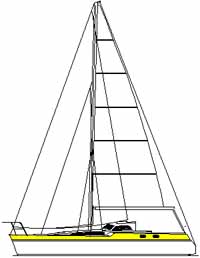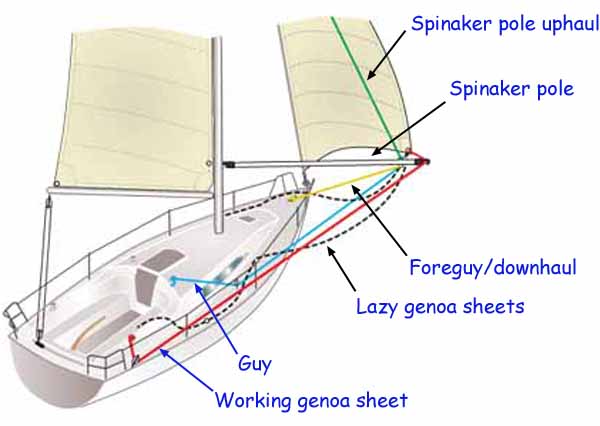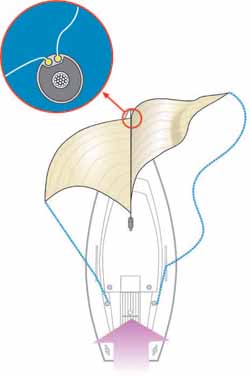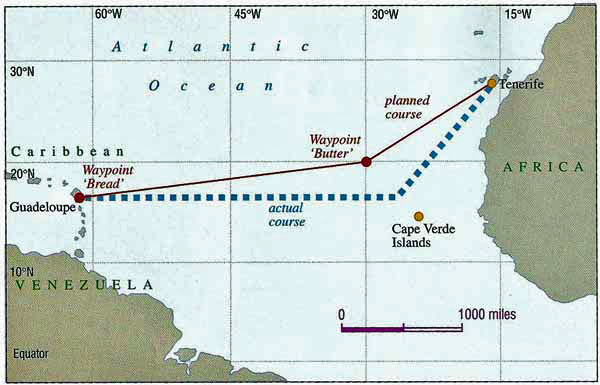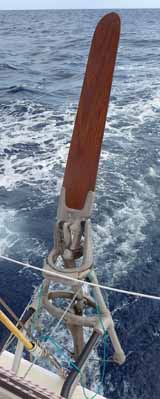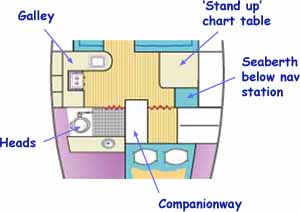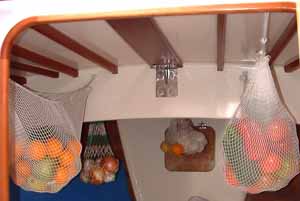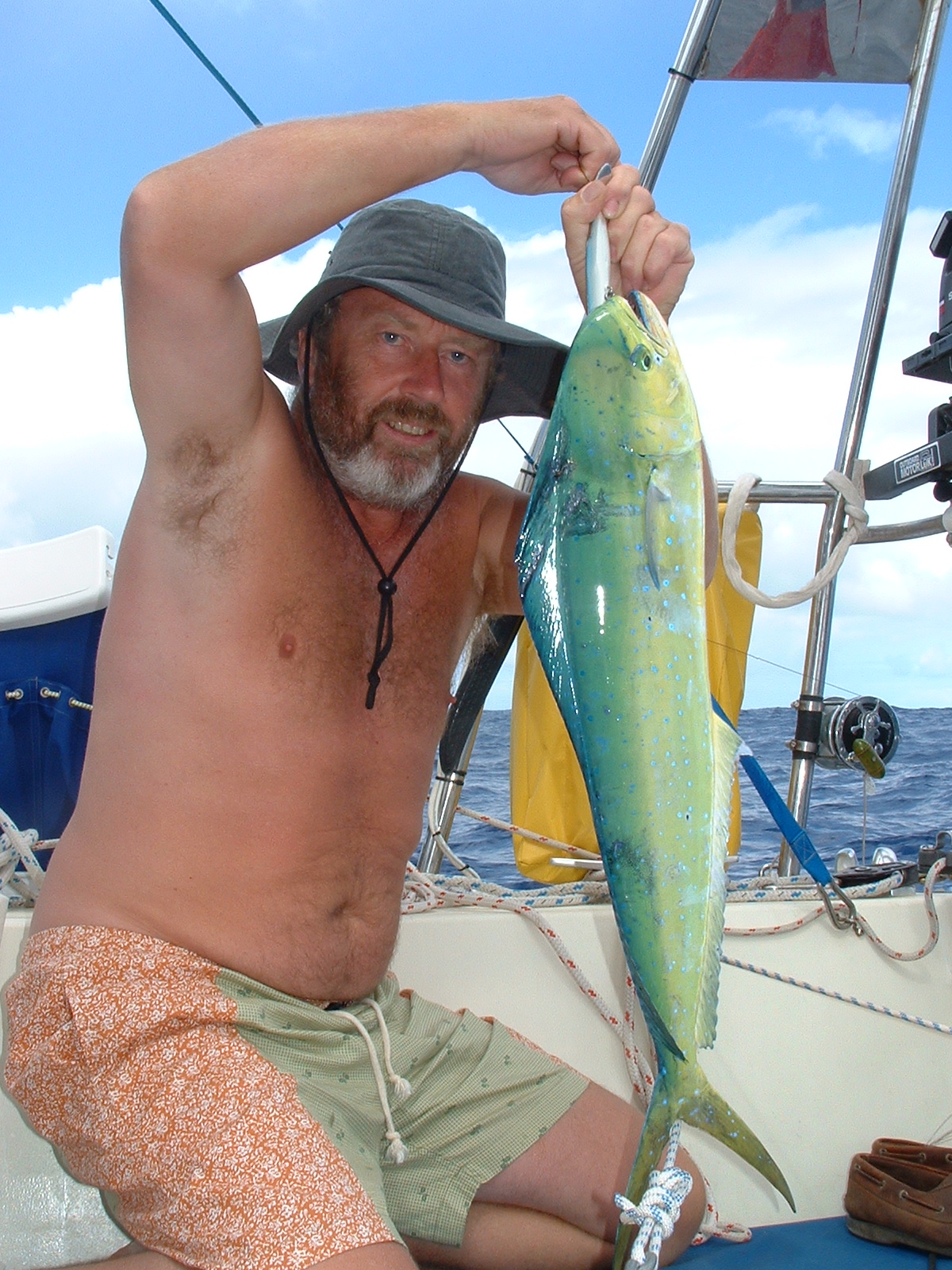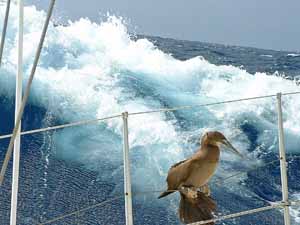This is an archived article from a Malaysian Newspaper, interviewing Azhar Mansor prior to his 1st Anniversary returning back from solo round the world trip. He did it more than 4 months before the new millennium (2000). This is an example of courage and undying attitude to accomplish his mission. His struggles, inspires me !
LANGKAWI - The success of Datuk Azhar Mansor in sailing solo round the world last year has been described by Prime Minister Datuk Seri Dr Mahathir Mohamad as a unique achievement among the 22 million Malaysians.
Azhar Mansor Explains Significance Of Historic Odyssey
 |
| Picture of Yacht "Jalur Gemilang" in Langkawi |
LANGKAWI - The success of Datuk Azhar Mansor in sailing solo round the world last year has been described by Prime Minister Datuk Seri Dr Mahathir Mohamad as a unique achievement among the 22 million Malaysians.
Celebrations marking the first anniversary of Azhar's triumphant return from his voyage will be launched by Dr Mahathir here tomorrow.
What is the significance of his historic achievement and what does Azhar want the younger generation, especially students, to learn from it?
In conjunction with the first anniversary of his feat on the Jalur Gemilang yacht, Azhar recapped the historic event.
He spoke of the attitude and roles required of the younger generation in tackling the challenges of the new millennium and of his determination to imbue a new spirit in society for the same purpose.
Question: Can you explain the celebrations to mark the first anniversary of your success in sailing round the world?
Answer: Actually, it is in conjunction with the first anniversary of the return of Jalur Gemilang, not Azhar Mansor. If it's about Azhar Mansor's return, people may say we are trying to promote something old.
The certificate of world record belongs to Jalur Gemilang, I was only the skipper.
I've been back for almost a year, so the focus and commitment now is on sharing my experience with the public. The experience one possesses is not something to be traded; you can't hang it up for display by keeping it. It is my duty to share my experience, as the role played by Malaysians while I was sailing was also an important factor.
I have to concentrate on sharing my experience, especially with the younger generation in schools, associations, youths and NGOs, including institutions of higher learning. So this process never stops.
This is an ongoing programme conducted with the cooperation of the Youth and Sports Ministry, associations and private companies. Private companies do finance programmes for youths.
Q: So this Aug 11 is the first anniversary...?
A: Aug 11 is the first anniversary of Jalur Gemilang's return and people feel it should not be a grand anniversary. It means we should remember the spirit we all felt when the Jalur Gemilang reached home. Everyone watched it on TV. This reflects continuity; we do not want the spirit to fizzle out, not that we do not want people to forget Azhar Mansor. The spirit was clearly visible. Thousands of Malaysians came (to await Jalur Gemilang's return). If possible, we want to maintain and remember this spirit. Just in case people have the wrong idea that Azhar is doing this so that his name will not be forgotten.
The spirit of patriotism prevailing on that day, permeating people of all races and religions, that is what we want to remember. That is what we hope to do every year, not just on the first anniversary. We will try to organise programmes, anything which can instil this spirit in the people. In conjunction with this year's anniversary, we want to launch a special documentary. The book is not ready yet, no time to give it full concentration. On that day we will also launch an Internet portal dedicated to young Malaysians.
The government has been calling for the younger generation to be exposed and given access to IT, but if they venture into IT or Internet, there is no portal or web dedicated to them. To build up on the spirit and programmes implemented, we feel there is a need for a special portal related to them. All sorts of TV channels, various types of programmes are in it.
Its address will be announced on that day and its launch will not be grand. We will do it on a moderate scale and air it live on NTV7. We don't have NTV7 in Langkawi but on that day we will.
Q: From the programmes conducted, programmes to share information, what has been the response from the target group?
A: Generally, I am encouraged... touched by the public support, particularly from the younger set. In programmes on sharing of experience and exchange of opinions, the focus is on dialogue, and from there we can exchange views on how to enhance an individual's self-esteem. So the target group is there but as to how many people can get the message and benefits of the programmes, we cannot make a measurement, that is up to the individuals concerned. But in terms of support and going to universities, there were thousands of people. In the case of Universiti Malaya, there were 6,000 people.
At UM, they used three halls, others watched on (closed-circuit) TV.
Q: How about your about time with family?
A: Of course, I could not spend much time with my family but it is just like before. For example, if duty requires me to be away for eight days, they can accept it.
Q: What do you hope to achieve with this sharing-of-experience programme?
A: As a developing nation, we have our vision and the government has its programmes. I as an individual, private enterprise, on whom people have placed a lot of hope have decided to share my experience to open the minds of the younger generation - that the Malaysian race is capable of undertaking international-level endeavours and achieving excellence. I am talking not only about sailing but various fields. One visible weakness is that sometimes they lack a clear goal in life. So when we lack this, our efforts do not amount to a struggle and things grind to a halt midway. We want to be successful in our struggle. Our weakness is that many young people do not have a clear direction in life. We can guide them until universities, but after that the objectives are not so well-defined - what to do upon graduation, what they want, their role in life, role in society, role in this world. Because of this we try to instil positive spirit in them and open their minds so that they are mindful about vision and struggle.
We need a struggle to fight a proper war, otherwise we will die. So our weakness is that we lack a struggle. Even if they have a struggle, they are just following others, not their own struggle.
Q: What do you think of your sacrifices?
A: My present role is as an individual giving a bit of inspiration to the public. So I try to play a role in helping the government and society. Based on my planning, I will slow down at the end of the year because there are more meaningful things to focus on. I would have visited many places by then, so I need to slow down. I will make fewer visits so as to concentrate on other things, like the portal dedicated to Malaysian youths. The theme of this portal is to build a second generation or the so-called Version 2. The Version 1 mind is considered not suitable, and we want to develop them for the new millennium.
So when the PM says new Malaysia, we say Version 2 in the IT terminology.
That will take a lot of effort and that is why I want to slow down at year-end and focus on this portal to ensure it contains constructive material. Apart from the Internet, we will also pay attention to physical activities. It will not work if everyone just sits in front of a computer. We must have physical programmes complementary to the material in computers.
Q: What about the launch of the special documentary?
A: We will have a launching to be shown live, and after that if many people are interested they can come and watch it live, not by invitation but open to the public. The public can come for the event expected to be held at Awana (Porto Malai Resort).
It is a special documentary on the Jalur Gemilang Challenge, not a documentary on Datuk Azhar.
It covers the aspects of building the boat, comments before and after and recordings which I made when I went sailing before.
Q: What if your name were to disappear?
A: To me, an endeavour should not be for the sake of establishing a name but should be made in the course of a struggle. When a struggle is fulfilled, it does not mean the name of the person involved is important. The success of that struggle should inspire the people. I am not asking the people to follow Azhar's footsteps per se but his struggle and efforts.
If people want to emulate Azhar, can they do it my way?
The fighting spirit is important. They say the key to excellence is self-esteem and fighting spirit.
Like I said, it started as a personal struggle but sometime in 1995 I saw the need to inject into it the patriotic and nationalistic spirit to bring it to a fruitful conclusion. It had to be continued for the sake of the country and race. It is not strong enough if merely motivated by a personal struggle, it needs to be injected with the nationalistic spirit.
That is why on my return I felt indebted to the people, those who have followed my journey and sent me e-mail, prayers and words of encouragement. Now is my turn to share my experience with the people. But I can't be doing this forever as a profession. I am not a lecturer or motivation expert. So if I just go on giving lectures, when can I do other things?
Q: What about Jalur Gemilang's condition?
A: At the moment, the facilities in this place (Awana Porto Malai) are not very suitable for hosting Jalur Gemilang. But because of the spirit associated with it, delegations to Langkawi wishing to view and take photographs of Jalur Gemilang, we decide to leave it here. Once in a while we take it out for some testing. The public will not get to see it if I berth it at another place. I think that is not appropriate.
Q: What about the project to set up the Jalur Gemilang Gallery?
A: Lada (Langkawi Development Authority) is keen, and we will cooperate. My style is I am hesitant to get the government and people's money involved. The millions to be spent on building a sophisticated gallery may be better spent on other programmes. If possible I want to do it on my own but that will take time. If they need cooperation, we can help by way of joint venture.
Q: What about the potential for the yachting industry here?
A: In terms of facilities, I think we are adequate but to develop we need all quarters to play their role. I cannot do it alone.
I mean the facilities are there for people to venture into this industry. But there must be enthusiasm, and all in the local government, the people of Langkawi, schools and associations must play their role.
That is why I said I need to slow down at the end of the year to concentrate on other things. I want to boost yachting activities in Langkawi. That is what I meant by matching physical programmes with the portal. But we have to see the response and role of all parties before we can start. Even 10-20 million (ringgit) will not be enough if you want to do it alone. There must be support from the government, entrepreneurs, schools and people wishing to see individuals improve.
Q: Can the marine industry here be said to have potential?
A: The marine activities should be at a high level... we are a bit behind... especially in Langkawi. Not just potential but we should already be established, Langkawi for the yachting industry. I do not know how people can promote Langkawi as a legend but not for yachting. That is why the role of all quarters is important. They promote the legend of Langkawi and people say they come to see the Mahsuri Mausoleum, all this is not to intensify the marine activities.
Q: Is it because of the high cost?
A: Not because of high cost. There are now already close to 20-30 small boats sailing here. If it were in the West, not just dozens but hundreds of boats would have come here already.
I saw in Australia hundreds of boats berthed at a small bay. And various types of boats, various aims - recreation, racing, and living on boats.
Q: Has this got anything to do with the lifestyle of the Malaysian society?
A: Yes. Yachting is not part of our background. But the history is there, facilities and beauty are also there, only that they are not explored. Maybe it is because in Malaysia people would rather work in banks, become bank managers and avoid physically demanding activities. They don't see that such robust work can help to mould discipline.
Thousands of engineers graduate throughout the world each year but what makes one better than another? That has to do with the individual's struggle, not the university. A university's work is to see students graduate.
An individual's struggle will determine who emerges the best. The government cannot do much.
We are used to the government providing facilities. That is why I want to make the gallery on my own without government involvement, if possible. I want it like the portal for the younger generation. By right it should be Rakan Muda or the Youth and Sports Ministry doing it but we want to do it on our own. Of course, the ministry is interested to cooperate but we do not want; we want to do it on our own, to complement their programme. We want to work together, not to compete with them. They have their own programmes, we have ours.
That is the spirit. A weakness among most of us is to be too dependent on the government. How long are we going to wait if the government does not do or give? Some people complain too much. Pampered.
Q: It has been almost a year. Don't you miss sailing?
A: Not that I long for it, but my style is to go by my commitment and I give my best to the task at hand. The rest is not a problem. Of course, if possible I want to sit here and relax, go to sea, but is that part of the commitment or focus? It is not a problem not to do something which is not a commitment.
Q: During the sessions to share your experience, were you asked funny questions?
A: There were all sorts of questions, and from these questions sometimes we can read the weakness of our people.
But there are still people who believe that to circumnavigate the world you need magical powers and charms as they have been told of mystical powers, but such things are not important.
We must be in touch with reality to succeed, not depending on mystical powers. If we are shot, we will die.
We need a religious foundation but must be mindful of reality. If I had embarked on that journey without being technically, mentally and physically prepared, I would not have made it back. I could not have depended on magic powers. If hit by 20-feet high waves, I could not possibly ask the waves to stop.
In our culture, we do not accord enough respect to other individuals. We want other individuals to be like us. That is not possible; he is he, we are we.
Because of this many people just follow certain individuals, because of their own weaknesses and the weakness of their leaders. The head wants them to do it his way, without regard to individual character. No two individuals are the same and they have different roles in life.
Q: How do you feel about your name being frequently mentioned by the Prime Minister?
A: I do not deny that this is an honour for me. I do not abuse this honour and recognition. To me, each time I exchange greetings with someone, each time my name is mentioned, the responsibility on me gets heavier, not that I get more popular. A young girl once sought my autograph with the question "Pakcik (uncle), is it fun to be glamorous?" I replied, "Young girl, this is not a question of glamour, it is my responsibility. I come here because it is my duty, I do not come for the glamour."
At one programme, a university student asked how I felt when my name was misused. I do not see my name being misused.
You are not the only one to ask this question. To me as an individual, I do not see any abuse. But I do not deny that my name gets frequent mention.
In line with government efforts to stress the building of self-esteem and Melayu Baru, there is a lot to talk about the spirit of struggle and legends.
He (Dr Mahathir) mentioned my name with the aim of instilling in the people the spirit needed for building self-esteem. So, I hope that every year we can have a programme to inculcate this spirit in conjunction with the National Day celebrations. Every Aug 11 is the Jalur Gemilang Challenge Day and Aug 31, the National Day. I want this to be maintained and I hope someone can continue this tradition when I am gone.
Q: What are your hopes for others to continue with excellence?
A: I hope more people can achieve similar success, not only me.
When you want to take on unusual challenges, write down clearly what you want to do, how to do it, and why you want to do it. Sometimes people know what they want to do, but are not clear about how to do it. Sometimes people know what they want to do, know how to do it, but do not know why they want to do it.
He wants to break a record. Why does he want to do it? Because of money... not enough. He must be very clear about the task. That means it must be accompanied by determination and sincerity. When we are clear about our duty and are committed and sincere about the matter, it will become a struggle. A struggle is meant to be fulfilled, only time will tell.
 |
| West-East Route |



